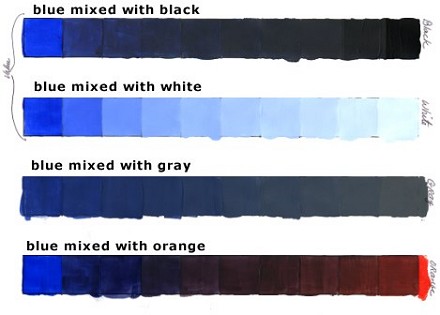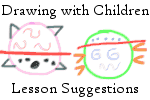How to use Scale Chart I
 You
will need these colors no matter what color you choose: red, blue, yellow,
black, and white. You will also need paint brushes, water, a paint mixing tray,
a paper towel, and possibly a piece of scrap paper. Either use the printout or
draw something like the printout on construction paper (4 rows around 1 inches wide and 10
inches long and divided into 10 1-inch sections.)
You
will need these colors no matter what color you choose: red, blue, yellow,
black, and white. You will also need paint brushes, water, a paint mixing tray,
a paper towel, and possibly a piece of scrap paper. Either use the printout or
draw something like the printout on construction paper (4 rows around 1 inches wide and 10
inches long and divided into 10 1-inch sections.)
The file: Scale Chart I - with gray lines
Scale Chart I - with gray lines
For more choices in color comparing printables go to Color Study Printables and Color Wheels
Choose one of the primary or secondary colors as the main color for the exercise and paint as described below.
![]() Tint- In the
first row of 10 squares, paint the first square the main color. Add a little
white perhaps a drop or two to your main color, paint that in the next square of
the same row, continue lightening the color with white and each time painting
the next square in the same row. Hopefully by the time you have arrived at
square 10, your color will be very pale, almost white. This is the tint value
scale.
Tint- In the
first row of 10 squares, paint the first square the main color. Add a little
white perhaps a drop or two to your main color, paint that in the next square of
the same row, continue lightening the color with white and each time painting
the next square in the same row. Hopefully by the time you have arrived at
square 10, your color will be very pale, almost white. This is the tint value
scale.
![]() Shade- On the next row do the same with black paint.. Paint the first
square with your main color, add a very tiny amount of black (go easy on the
black) paint the next square and so forth.
Shade- On the next row do the same with black paint.. Paint the first
square with your main color, add a very tiny amount of black (go easy on the
black) paint the next square and so forth.
![]() Tone- On the 3rd row do the same
with your main color and a medium shade of gray. To get gray, add some black
paint to white until you have a medium shade. Paint the squares in the same
manner as before. This is a saturation value scale.
Tone- On the 3rd row do the same
with your main color and a medium shade of gray. To get gray, add some black
paint to white until you have a medium shade. Paint the squares in the same
manner as before. This is a saturation value scale.
![]() Intensity- On the 4th row do
the same with your main color and its complement. (The color located opposite
your main color on the color wheel.) Make the complement if it is a secondary
color and then do as before to make the value scale. This one is a intensity
value scale.
Intensity- On the 4th row do
the same with your main color and its complement. (The color located opposite
your main color on the color wheel.) Make the complement if it is a secondary
color and then do as before to make the value scale. This one is a intensity
value scale.
Example with blue as the main color:



 Lesson 1: Learning the Basics
Lesson 1: Learning the Basics This page brings together forms that can be used for language arts.
This page brings together forms that can be used for language arts.


